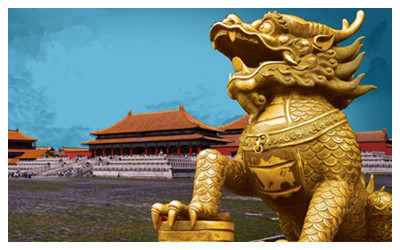Skype: neodalle-travel
Tel: +86 135 7447 2266
E-mail: sales@visitaroundchina.com

 The qilin, also spelled kylin (麒麟) is a mythical hooved Chinese creature that is said to appear in conjunction with the arrival of a sage. It is a good omen that brings rui (瑞 roughly translated as "serenity" or "prosperity"). It is often depicted with what looks like fire all over its body.
The qilin, also spelled kylin (麒麟) is a mythical hooved Chinese creature that is said to appear in conjunction with the arrival of a sage. It is a good omen that brings rui (瑞 roughly translated as "serenity" or "prosperity"). It is often depicted with what looks like fire all over its body.The Nature of the Beast
Although it looks fearsome, the qilin only punishes sinners. It can walk on grass and yet not trample the blades and it can also walk on water. Being a peaceful creature, its diet does not include flesh. It takes great care when it walks never to tread on any living thing, and it is said to appear only in areas ruled by a wise and benevolent leader (some say even if this area is only a house). It is normally gentle but can become fierce if a pure person is threatened by a sinner, spouting flames from its mouth and exercising other fearsome powers that vary from story to story.
The Qilin is the lord of all hairy creatures (mammals), while the Phoenix represents the feathered, Man the naked, the Dragon the scaly and the Turtle the armored.
Variations
There are variations in the appearance of the qilin, even as seen in a single country such as China, owing to cultural differences between dynasties and regions.
Ming Dynasty Example
In the Ming dynasty of China (1368–1644) the qilin is represented as an oxen-hooved animal with a dragon-like head surmounted by a pair of horns and flame–like head ornaments.
Qing Dynasty Example
The qilin of China's subsequent Manchurian dominated Qing dynasty (1644–1911) is a much more fanciful animal. Manchurian depictions of the qilin depict a creature with the head of a dragon, the antlers of a deer, the skin and scales of a fish, the hooves of an ox and tail of a lion.
 Ask Questions ?
Ask Questions ?